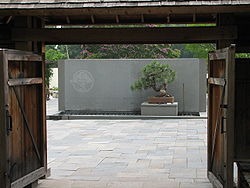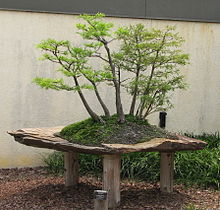- National Bonsai Foundation
-
Coordinates: 38°54′45″N 76°58′08″W / 38.9124°N 76.9689°W
National Bonsai Foundation 
Established 1982 Location Washington D.C., United States The National Bonsai Foundation (NBF) is a nonprofit organization that was created to sustain the National Bonsai and Penjing Museum. NBF also helps the United States National Arboretum show the arts of Bonsai, and Penjing. The National Bonsai and Penjing Museum is located on the 446-acre (1.80 km2) campus of the US National Arboretum in Washington, D.C. Each year over 200,000 people visit the museum.[1]
Contents
Mission statement
"The National Bonsai Foundation is a section 501 (c) (3) nonprofit organization established in 1982 to sustain the National Bonsai and Penjing Museum. It cooperates with the U. S. National Arboretum by offering financial support and advice to the Museum.
This private/public collaboration between the Foundation and the Arboretum enables the Museum to promote the art of bonsai and penjing to visitors through masterpiece displays and educational programs while also fostering intercultural friendship and understanding."[2]
History
In 1976, the country of Japan gave the country of The United States of America a gift of 53 Bonsai trees. The trees were selected by the Nippon Bonsai Association, with financial assistance from the Japan Foundation. The trees arrived at the Potomac Bonsai Association, and volunteers worked with the staff of the US National Arboretum to keep the trees in display condition. In 1979, Janet Lanman talked with Dr. John Creech, Director of the Arboretum the possibility of adding American bonsai to the Museum. Dr. Creech proposed this idea to well known Bonsai teacher Marion Gyllenswan. An independent body of Bonsai authorities was assigned to review private Bonsai collections, possibly as a part of a national collection. These Bonsai authorities were called the National Bonsai Committee. In 1982, the National Bonsai Committee was reformed into the National Bonsai Foundation. The National Bonsai Foundation recruited people from all across the country to be directors. The members of the first Board were Marybel Balendonck, Larry Ragle, Melba Tucker, Frederic Ballard, and H. William Merritt. MaryAnn Orlando served as the Executive Director and principal fund raiser for the National Bonsai Foundation.
In 1986, the ten year anniversary of the gift from Japan, the National Bonsai Foundation announced that they would be building the American Bonsai Pavilion to compliment the Japanese Pavilion, and to showcase a collection of North American Bonsai. This became a reality in 1990. On October 1, 1990 the American Bonsai Pavilion was dedicated to two American Bonsai Masters. The Yuji Yoshimura Educational Center is a work space, and a classroom. The John Y. Naka North American Pavilion provides the display area for the North American bonsai collection.[3]
With donations from the Bonsai community, the National Bonsai and Penjing Museum grew greatly in the early 1990s. The Kaneshiro Tropical Conservatory (named for "Papa" Kaneshiro, the father of Hawaiian Bonsai) was added for delicate trees. A behind the scenes greenhouse was also added for trees in development.[4]
Collections and exhibits
 The Japanese White Pine (Pinus parviflora 'Miyajima') bonsai. It has been in training since 1625. It survived the atomic blast in Hiroshima.[citation needed] It resides in the Japanese Collection.
The Japanese White Pine (Pinus parviflora 'Miyajima') bonsai. It has been in training since 1625. It survived the atomic blast in Hiroshima.[citation needed] It resides in the Japanese Collection.
The National Bonsai and Penjing Museum has four collections. The Japanese, the Chinese, the North American, and the Viewing stone. In addition to the collections, it also has pavilions, courtyards, and gardens. The National Bonsai and Penjing Museum has a number of temporary exhibits going on at one time.[5]
The Japanese Collection
This collection started with the 53 original trees from Japan. These trees spent a year in quarantine
 This trident maple, Acer buergerianum, has its foliage and stems trimmed in the shape of a dragon. This is in the Chinese penjing Collection
This trident maple, Acer buergerianum, has its foliage and stems trimmed in the shape of a dragon. This is in the Chinese penjing Collection
after arrival, and on July 19, 1976 were dedicated in a ceremony with many dignitaries from Japan, and the USA watching. Secretary of State Henry Kissinger acted for the American government, and accepted the trees. The collection which is now 63 trees can be seen in the Japanese Pavilion in April through October. From November to March, they can be seen in the Dr. Yee-sun Wu Chinese Pavilion.[6]
The Chinese Collection
 John Naka's masterpiece, Goshin, is on display at the United States National Arboretum. It was donated by Naka to the National Bonsai Foundation in 1984. Located in the North American Pavilion.
John Naka's masterpiece, Goshin, is on display at the United States National Arboretum. It was donated by Naka to the National Bonsai Foundation in 1984. Located in the North American Pavilion.
The Chinese collection (also known as the Penjing collection) in the National Bonsai and Penjing Museum is in the Yee-sun Wu Chinese Garden Pavilion. This pavilion is named for Dr. Yee-sun Wu (1905-1995), who collected penjing in Hong Kong. In 1983, Janet Lanman, a NBF Board Member asked Dr. Wu if he would like to help include penjing in the Museum. Dr. Wu was delighted at the idea, and gave funding to build a pavilion, as well as donating many penjing trees. In 1988 the museum was renamed National Bonsai and Penjing Museum.[7]
The North American Collection
Most of the trees in the North American Collection are in the John Y. Naka North American Pavilion. The tropical species of this collection are in the Haruo Kaneshiro Tropical Conservatory. The 63 tree collection was made entirely by North Americans. The John Y. Naka North American Pavilion was dedicated in 1990 to John Y. Naka (1914-2004). His world famous Bonsai "Goshin" (seen right) is displayed at the entrance to the Pavilion. The trees in this collection can be seen on display in spring, summer, and fall. In winter they are in the Chinese pavilion. the Haruo Kaneshiro Tropical Conservatory named for "Papa" Haruo Kaneshiro (the father of Hawaiian Bonsai) was completed in 1993.[8]
 A suiseki at the National Bonsai and Penjing Museum of the United States National Arboretum
A suiseki at the National Bonsai and Penjing Museum of the United States National Arboretum
The Viewing Stone Collection
Besides having many beautiful Bonsai trees, the National Bonsai and Penjing Museum also has a world class collection of viewing stones. Bonsai and viewing stones are closely related. Both show great respect for nature, and when the small scale plants and stones are combined, the whole of nature can be imagined.
This collection began with six viewing stones that accompanied the 53 original Bonsai. The collection today has a total of 105 stones from all around the world. The stones can be seen in and around the Mary Mrose International Pavilion. The Melba Tucker Suiseki and Viewing Stone Display Area has its stones periodically changed in themes.[9]
References
External links
Categories:- Bonsai
- American national museums in Washington, D.C.
- Arboreta in Washington, D.C.
- Natural history museums in Washington, D.C.
- Museums established in 1976
Wikimedia Foundation. 2010.





